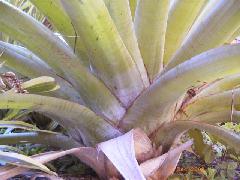 . . .
. . . 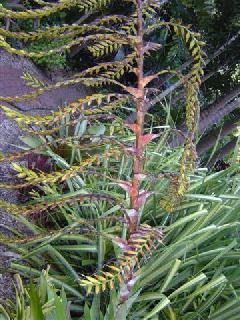 . . .
. . . 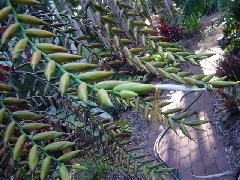
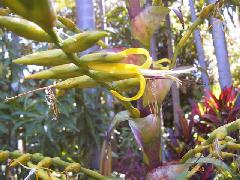 . . .
. . . 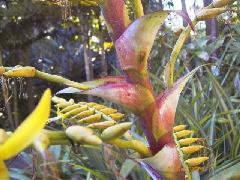 . . .
. . . 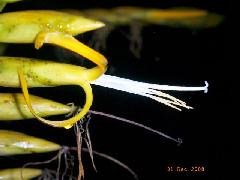 . . .
. . . 
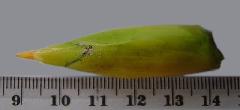 . . .
. . . 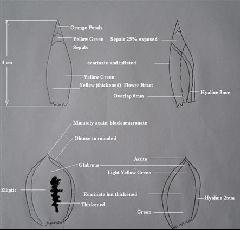 . . .
. . . 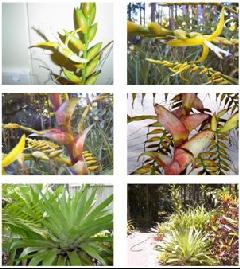 * Group photo.
* Group photo.
Right - Plant MK. Grown in bright light. Labelled "Imperialis Green Form". |
 . . .
. . .  . . .
. . . 
 . . .
. . .  . . .
. . .  . . .
. . . 
 . . .
. . .  . . .
. . .  * Group photo.
* Group photo.
Right - Plant MK. Grown in bright light. Labelled "Imperialis Green Form". |
So far I have found two rare species of Alcantareas in Brisbane and possibly a third in Far North Queensland. The first that I discovered was a large night flowering plant. I did a lot of taxonomical work on this and sent my work sheets to prominent botanists in Brazil. The reply was that it was a known as yet undescribed species. So that we can communicate on this I have given it a temporary name of Al. nova aff. patriae RSS. One of the two Brazilian botanists suggested it had an affinity with Alc. patriae. The third one will probably be a new species from inland Minas Gerias where a new population of Alc. extensa and related species have been found in recent times. The original clones were found in Espirito Santos so there might be a lot of reclassification and new species described when this is all linked up. Only Alc. turgida (2007) has been published so far. How this third, possibly yet to be described species, got into the country is anybody's guess. If you read Arno King’s paper in Bromeliaceae 2002, we could make a good stab at how the other two got in.
Back to the second one. This all started after I requested in Brom Watch (a monthly rag that I write) that I would like photos of flowering Alcantarea sent to me as their naming is in such a mess and I hoped to sort some out. Margaret Kraa (MK) sent me a photo and subsequent material to study. By this time I had a good size data bank as a result of my previous study. Firstly I compared data with ones I had heard were around. Each time I found a major difference so excluded these plants. I worked through the remaining species and at the end I was left with only one species. I think I had eliminated 26 species. A lot of time needed. This meant it was Alc. patriae or some hybrid. I sent work sheets and photos to the botanist who described Alc. patriae in 2007. Below I have prepared an easy to read version for non-botanists.
It was a great joy for me when Leonardo wrote back and confirmed that Margarets’s plant was Alcantarea patriae.
Could you believe this? — Arnold James (AJ) invited me to his farm and there was another one in flower. Both Arnold’s and Margaret’s plants carried different labels of course. Understandable when it would not have even been described at the time.
Similarities between the Brisbane Alcantarea and Alc. patriae.
(This was drawn up before I knew they were the same species.)
Both are large plants flowering above 2 metres. Both appear to have short trunks covered my dead leaves. They carry a large number of green leaves and the rosettes assume much the same shape. Leaves are rather narrow suberect and nearly straight and are covered with cross bands of white epiculate wax.
Leaves are same, concolour green, leathery and linear with transverse chalky striping. Leaf tips are acute.
Scape is erect and appears to be green in both cases. First branch is a similar distance above the plants leaves.
Photographs show primary bracts to be similar in shape and colourations.
Branches: Both plants have a large number (20-30 combined range) of erect to semi erect branches with between 11 and 35 well spaced flowers per branch.
Flowers: both have lax, distichous and not secund flowers (important for separation from another group of large Alcantareas)
Petals: both fit within 8.5 to 10 cm in length, 8 to 10 mm wide.
Floral Bracts have no keels but are both thickened towards the centre and towards the apex. Both have nerved membranous margins. Both are yellow to golden yellow and smooth. Both have the same dimensions.
Sepals both obovate with graded yellow to green yellow markings. Both with same dimensions.
Petals, yellow, anchor shaped at anthesis, becoming recurved and flaccid with time.
Stamens of similar size and both are not spreading.
Scent : Both plants are scented.
Differences
Scape bracts of Brisbane plants could be more foliaceous than those shown with patriae (very distant photo). Look equally divergent.
Sepals and Floral Bracts more rounded and slightly more symmetrical with patriae. I have noticed with the Brisbane plant that with older flowers the subacuminate tip does fall off which rounds off the tip in the case of the floral bract. The sepal is far more rounded in patriae and I never observed tip drop.
The ligulate petal appendages are some 40% longer in patriae. Patriae’s petals bend back more tightly as shown in the pictures.
Sterile bract numbers do overlap but the Brisbane plant is at the very lower end of the patriae scale.
Questions I can’t answer.
Have I not recorded something significant? I have done my best with one visit and many e-mails.
The branches of the Brisbane plant have become very drooped with age. Does patriae do the same? I would assume so.
Could the ligulate appendages data be a mistype? My data is 24 x 2 mm where as patriae is recorded as 34 x 2 mm. I have a pressed sample and mine is right for me.
Conclusion
I will let this data sit in the web site for 6 months. If nothing evolves from the taxonomists I will label my plant Alc. patriae (RSS). If it is debunked I will register it as Alc. ‘Brisbane Beudy’
Acknowledgement: Thank you Margaret Kraa for staying with me on this project and thanks to Arnold James for his enthusiastic but late involvement.
Note: Groupings like (20 -30) mentioned above only indicate that the two plants both fit and overlap somewhere in this range not over the whole of the range.
Response from the botanist who actually described this species.
I sent him all my work sheets including drawings. His response is below.
You've done a great job and did find A. patriae in Australia. I have not seen the end of blooming at the type locality, all the plants I depicted in my paper are at the beginning of anthesis, but a friend of mine went to the same place later and he noticed that branches would bend downwardly at the end of flowering period.
Good job and it is good to know that A. patriae is cultivated far away from its homeland.
Best...
Leonardo M. Versieux
Instituto de Botânica
Seção de Curadoria do Herbário
Av. Miguel Stéfano 3687, São Paulo-SP, Brasil 04301-902
Plant Saxicolous, caulescent, 2-3.7 m high, propagating by basal shoots.
Rosette infundibuliform, storing a large amount of water, ca. 1.5 x 1.6 m.
Leaves numerous, suberect, nearly straight;
Sheaths elliptic to widely ovate, 30-43 x 15-21 cm, pale brown with brown spots and pale brown inclined lines abaxially, white along the insertion becoming pale brown adaxially when fresh, dark brown becoming pale brown abaxially, concolor pale brown adaxially when dry, densely brown lepidote on both faces, coriaceous, margins membranaceous, inconspicuously wine-red spotted when fresh, strongly involute when dry;
Blades ligulate to ligulate-lanceolate, (0.9-)1-1.2 m x 9-10 cm, concolor green, with transversal white wax bands on both faces, densely brown lepidote abaxially, glabrescent adaxially, plane to slightly canaliculate, suberect, coriaceous, distinctly nerved with some prominent veins, margins green, weakly revolute when dry; blade apex acute, green, twisted, rigid, discretely apiculate for ca. 5 mm.
Scape erect, straight, stout, 80-130 x 2.6-4 cm, terete to slightly sulcate, brownish green to purplish green, glabrous, distinctly nerved, internodes 3.5-6.5 cm;
scape bracts: the proximal ones, subfoliaceous, green, the middle and distal ones, ovate, apex acute, apiculus twisted, 15-35 x 4-6 cm, red at base passing to pale green, covered by white wax and densely brown lepidote abaxially, wine-red spotted and sparsely lepidote adaxially, imbricate up to 1/3 of the length, curved and spreading toward the apex, distinctly nerved, coriaceous, margins revolute when dry.
Inflorescence compound, heterothetic double raceme, ellipsoidal, 45-100 x 25-50 cm, main axis with 2-5 x 1-3 cm internodes;
primary bract ovate, apex acute, discretely apiculate, twisted, 4-13.5 x 2.8-5.5 cm, yellowish green to yellow along the base passing to waxy white abaxially, wine-red adaxially, densely brown lepidote on both faces, involute, curved, shorter than the lateral peduncles, distinctly nerved, coriaceous;
inflorescence branches 20-27,11-26(-32) flowered, suberect to erect;
lateral peduncles terete, (4-)12-22 x 0.7-0.9 cm, green, glabrous, finely nerved;
sterile bracts 2-4(-6), elliptic to oblong, apex acuminate, discretely apiculate, 3-3.8 x 1.5-2 cm, yellow, apiculus wine-red, glabrescent abaxiaily, densely brown lepidote adaxially, adpressed to the lateral peduncle, remote or nearly so, finely nerved, carinate near the apex, coriaceous, margins membranaceous; rachis weakly geniculate to straight, nearly quadrangular in cross section, 25-50 cm, green, glabrous, internodes (20-)30 x 7-8 mm;
floral bract suborbicular, apex obtuse, 3.5-4 x 4.5-5.3 cm, yellow, glabrous abaxially, brown lepidote adaxially, involving the calyx, smooth and carnose in the central portion, nerved along the laterals and margins, ecarinate but weakly thickened in upper 5 mm below the apiculus, margins membranaceous, yellowish hyaline in the fresh material.
Flowers with a weak sweet scent, distichous, patent to suberect at anthesis;
Pedicels nearly circular, 4 x 6 mm, green, sulcate;
Sepals obovate, apex obtuse, symmetric or nearly so, 3.2-3.7 x 2.3-2.7 cm, exceeding the floral bracts in 10-15 mm, yellowish green on base, completely yellow toward the apex, glabrescent abaxially, brown lepidote adaxially, carnose, ecarinate, margins membranaceous and yellowish hyaline in the dry material;
Petals ligulate, constricted around the apex of the sepals, apex rounded, 85-90 x 9-10 mm, yellow, inconspicuously white spotted, turned backward and weakly spiraled at anthesis;
petal appendages 2, ligulate, ca. 34 x 2 mm, longitudinally adnate to the petal for 29 mm, carnose and protuberant, apex acute, asymmetrical; stamens not spreading;
filament terete, weakly complanate in the 1/2-inferior portion, 70-74 x 1.7 mm, white; anther linear, ca. 16-18 x 1.4 mm, yellow, dorsifixed near the base; style trigonous-rounded in cross section, ca. 85 x 2 mm, white; stigma lobes convolute-patent, 2.5-3 mm, white;
ovary weakly hexagonal in cross section, with inconspicuous ribs, ca. 15 x 3-4 mm, green, hypanthium ca. 6 mm; ovules numerous, ca. 3 mm.
Capsule and seeds unknown.
Additional material examined: BRAZIL. EPIRITO SANTO: Jeronimo Monteiro, Vila Cruzeiro, cultivated along the road BR-482, 20°48'04.8"S, 41'22'04.1 "W 131 m.s.m., 18-I-2007 [fl.], L.M. Versieux 364, A.M. Calvente & T. Trindade (SP).
Alcantarea patriae stands out among other species of the genus due to its great dimensions, particularly those of the leaf sheath, blade, rosette and the ample inflorescence. This new taxon resembles A. odorata that also has sweet scent flowers, but it can be separated from the latter by its shorter primary bracts, by the larger number and more spaced flowers, and by the straight to weakly geniculate rachis. Furthermore the flowering branches in A. patriae are usually longer, and suberect to erect (vs. patent to pendulous). The white wax cross bands along the blades or on the abaxial face of the scape bracts, and the rachis, which is almost straight or diverging up to 5° for each side (Figure 2C, E), are also very conspicuous characters that are useful to distinguish A. patriae.
Geographical distribution and conservation: Alcantarea patriae is helyophyte and grows over rocks between 120-400 m.s.m. at Jeronimo Monteiro County, Espirito Santo, Brazil. Individuals grow isolated or in dense groups frequently associated to Coleocephalocereus pluricostatus Buining & Brederoo (Cactaceae). Based on the IUCN criteria (IUCN, 2001), Alcantarea patriae can be considered Near Threatened (NT) due to its restricted occurrence area that is not within any protected area. Although the populations are usually large, with hundreds of individuals that are on inaccessible steep slopes, A. patriae is locally exploited for the ornamental trade. Also, granite mining threatens its substrate.
Phenology: Blooming in January
Etymology: Alcantarea patriae (i.e., belonging to the native land) was named after the bright colors observed in the inflorescence branches. The green of the lateral peduncles, and rachis, together with the yellow bracts, sepals and petals remind the colors of the Brazilian flag.